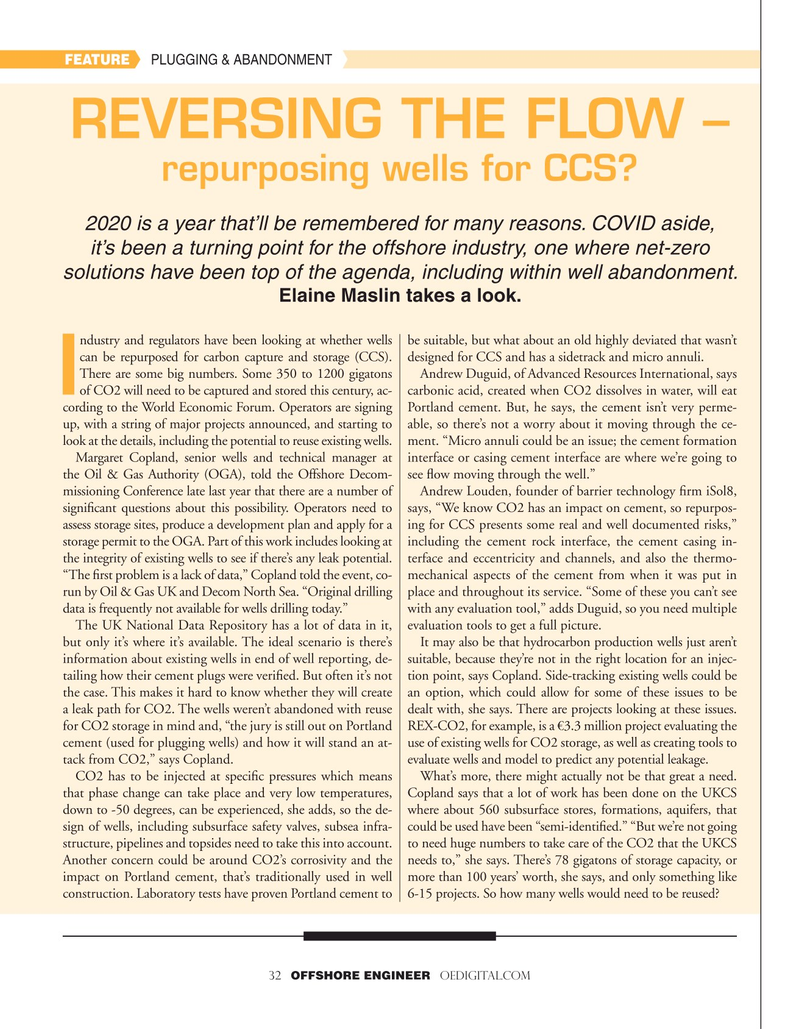
Page 32: of Offshore Engineer Magazine (Jan/Feb 2021)
Floating Production Outlook
Read this page in Pdf, Flash or Html5 edition of Jan/Feb 2021 Offshore Engineer Magazine
FEATURE PLUGGING & ABANDONMENT
REVERSING THE FLOW – repurposing wells for CCS?
2020 is a year that’ll be remembered for many reasons. COVID aside, it’s been a turning point for the offshore industry, one where net-zero solutions have been top of the agenda, including within well abandonment.
Elaine Maslin takes a look. ndustry and regulators have been looking at whether wells be suitable, but what about an old highly deviated that wasn’t can be repurposed for carbon capture and storage (CCS). designed for CCS and has a sidetrack and micro annuli.
There are some big numbers. Some 350 to 1200 gigatons Andrew Duguid, of Advanced Resources International, says
I of CO2 will need to be captured and stored this century, ac- carbonic acid, created when CO2 dissolves in water, will eat cording to the World Economic Forum. Operators are signing Portland cement. But, he says, the cement isn’t very perme- up, with a string of major projects announced, and starting to able, so there’s not a worry about it moving through the ce- look at the details, including the potential to reuse existing wells. ment. “Micro annuli could be an issue; the cement formation
Margaret Copland, senior wells and technical manager at interface or casing cement interface are where we’re going to the Oil & Gas Authority (OGA), told the Offshore Decom- see ?ow moving through the well.” missioning Conference late last year that there are a number of Andrew Louden, founder of barrier technology ?rm iSol8, signi?cant questions about this possibility. Operators need to says, “We know CO2 has an impact on cement, so repurpos- assess storage sites, produce a development plan and apply for a ing for CCS presents some real and well documented risks,” storage permit to the OGA. Part of this work includes looking at including the cement rock interface, the cement casing in- the integrity of existing wells to see if there’s any leak potential. terface and eccentricity and channels, and also the thermo- “The ?rst problem is a lack of data,” Copland told the event, co- mechanical aspects of the cement from when it was put in run by Oil & Gas UK and Decom North Sea. “Original drilling place and throughout its service. “Some of these you can’t see data is frequently not available for wells drilling today.” with any evaluation tool,” adds Duguid, so you need multiple
The UK National Data Repository has a lot of data in it, evaluation tools to get a full picture.
but only it’s where it’s available. The ideal scenario is there’s It may also be that hydrocarbon production wells just aren’t information about existing wells in end of well reporting, de- suitable, because they’re not in the right location for an injec- tailing how their cement plugs were veri?ed. But often it’s not tion point, says Copland. Side-tracking existing wells could be the case. This makes it hard to know whether they will create an option, which could allow for some of these issues to be a leak path for CO2. The wells weren’t abandoned with reuse dealt with, she says. There are projects looking at these issues. for CO2 storage in mind and, “the jury is still out on Portland REX-CO2, for example, is a €3.3 million project evaluating the cement (used for plugging wells) and how it will stand an at- use of existing wells for CO2 storage, as well as creating tools to tack from CO2,” says Copland. evaluate wells and model to predict any potential leakage.
CO2 has to be injected at speci?c pressures which means What’s more, there might actually not be that great a need. that phase change can take place and very low temperatures, Copland says that a lot of work has been done on the UKCS down to -50 degrees, can be experienced, she adds, so the de- where about 560 subsurface stores, formations, aquifers, that sign of wells, including subsurface safety valves, subsea infra- could be used have been “semi-identi?ed.” “But we’re not going structure, pipelines and topsides need to take this into account. to need huge numbers to take care of the CO2 that the UKCS
Another concern could be around CO2’s corrosivity and the needs to,” she says. There’s 78 gigatons of storage capacity, or impact on Portland cement, that’s traditionally used in well more than 100 years’ worth, she says, and only something like construction. Laboratory tests have proven Portland cement to 6-15 projects. So how many wells would need to be reused? 32 OFFSHORE ENGINEER OEDIGITAL.COM

 31
31

 33
33